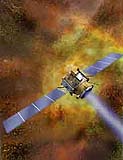| . |  |
. |
 More Deep Space Technology
More Deep Space Technologyby Bruce Moomaw Cameron Park - February 1, 2000 - Unfortunately, while the AutoNav computer worked beautifully, the MICAS was a diffferent matter -- it was the only "new technology" tested on DS-1 to run into really serious problems. It consisted of two cameras and two imaging spectrometers, all combined into a package of only 12 kg (less than one-tenth of what they would have weighed on the Voyager spacecraft). But the ultraviolet spectrometer failed completely -- apparently due to a broken connection -- and the CCD camera encountered problems in its star photography, both because of unexpected glare reflected off some of the spacecraft's parts and a higher-than-expected (though still small) degree of distortion in MICAS' optics. The latter was soon compensated for by modifying AutoNav's software, but the glare problem could not be completely solved -- and so AutoNav could see only some of its target asteroids, reducing its position accuracy during cruise to 900 km. Nevertheless, this was very good under the circumstances -- and so, as DS-1 approached its asteroid target, there was still confidence that MICAS' pictures were good enough to allow AutoNav to carry out its second assignment: locating asteroid Braille shortly before encounter, and steering DS-1 to an incredibly close high-speed 15-km flyby with an accuracy of only 2 km. It did indeed locate Braille 17 hours before the flyby -- but at this point a new problem struck: a small bug in AutoNav's software that caused DS-1 to put itself into a complete "safe" mode. Ground controllers managed to reverse this -- but when they rebooted DS-1's computer, it automatically deleted its record of having located Braille. The ground controllers compensated by processing the last AutoNav pictures of Braille (which had located it far more accurately than ground-based telescopes), and fed this location data directly to DS-1 to carry out its final course correction six hours before the flyby. This indirect procedure, however, did somewhat reduce the accuracy of the final flyby, so that DS-1 missed Braille by 26 km. AutoNav then resumed tracking Braille accurately, which would have allowed it to obtain pictures of the asteroid from only a few hundred kilometers distance -- but at only 28 minutes before the flyby, still another MICAS problem turned up. It was thought (falsely, as it turned out) that Braille was bright enough that closeup photos of it taken by the CCD camera would be smeared and blurred on the CCD plate, so DS-1 switched to its second camera -- an Active Pixel System camera which could adjust to brighter objects. Unfortunately, the APS camera turned out to be much less light-sensitive than ground tests had shown. It was completely unable to detect this dimly lit side of Braille -- and so, during its final approach, DS-1 had no clear idea of which way to point and thus missed all its planned closeup pictures. 15 minutes after passing Braille, DS-1 turned around to sight on it again -- and this time, since this side of Braille was more brightly illuminated, the APS camrea was able to lock onto it, so DS-1 obtained some extremely fuzzy long-range pictures that showed little more than its vague size and elongated shape, along with the aforementioned infrared spectra which were fairly good but which (as mentioned) pretty much just confirmed existing information. It should be emphasized that DS-1's main goal was not science, but engineering tests -- and in fact it was already rated successful before the Braille flyby, which was just "gravy". But NASA hoped to use the craft for as long as it could function -- and so DS-1 resumed thrusting with its ion engine in the hope that it would work long enough to fly by those two comets in 2001. However, in November, during a three-month respite from ion thrusting, DS-1's star tracker, which had been having intermittent problems before, failed completely -- and without a roll reference, the craft could not hope to steer itself in the proper direction for those two flybys. It began to look as though DS-1's career had come to an end.
DEEP SPACE ONE
|
| |||||||||||
| The content herein, unless otherwise known to be public domain, are Copyright 1995-2016 - Space Media Network. All websites are published in Australia and are solely subject to Australian law and governed by Fair Use principals for news reporting and research purposes. AFP, UPI and IANS news wire stories are copyright Agence France-Presse, United Press International and Indo-Asia News Service. ESA news reports are copyright European Space Agency. All NASA sourced material is public domain. Additional copyrights may apply in whole or part to other bona fide parties. Advertising does not imply endorsement, agreement or approval of any opinions, statements or information provided by Space Media Network on any Web page published or hosted by Space Media Network. Privacy Statement All images and articles appearing on Space Media Network have been edited or digitally altered in some way. Any requests to remove copyright material will be acted upon in a timely and appropriate manner. Any attempt to extort money from Space Media Network will be ignored and reported to Australian Law Enforcement Agencies as a potential case of financial fraud involving the use of a telephonic carriage device or postal service. |